A Logical Application of Gradient Factors Settings for Open-Circuit Tech Divers
As an active technical diving instructor for many years, I see many tech divers struggling to use Gradient Factors to their full advantage.
This article explains my own systematic and easily applicable approach to setting Gradient Factors for optimal off-gassing effect.
Disclaimer: Any opinions provided in this article only reflect my own successful approach to decompression using gradient factors. Dives requiring staged decompression are substantially more risky than dives that stay well within no-stop limits. No strategy can guarantee to protect every diver from DCS injury. Consequently, I reserve liability for any decisions you may make. Never risk your life on only one source of information. If you choose to make riskier dives, obtain the proper training and work up to them slowly to gain experience.
What Gradient Factors to Use?
The 2011 NEDU ‘Deep Stop’ study cast free-gas models in a less favorable light. Those results, coupled with follow-on commentary from subject-matter authorities, like Simon Mitchell, reversed the trend toward deep-stop profiles.
The popularity of Buhlmann ZHL-16C with Gradient Factors ascended back into supremacy amongst both the tech community and technical computer manufacturers.
As of 2019, nearly every single legitimate tech computer comes loaded with an iteration of the ZHL-16B/C algorithm with gradient factor control.
The Barrier of Gradient Factor Theory
From my observations, the biggest actual difficulty that divers encounter when using gradient factor controlled algorithms is that setting the high/low variables demands some explicit knowledge of dissolved-gas decompression theory.
I guarantee that some readers probably just took a mental leap towards the door just from having heard those words mentioned. Don’t run away yet folks – I have promised a simple and logical system, and that isn’t dependent on reading PhD-level papers.

To be fair, dissolved-gas decompression modeling is not a particularly lightweight subject at face value; and that in itself can be sufficiently daunting to deter many divers from sinking their teeth into it. The subject can even intimidate some technical diving instructors from attempting to teach it (but they should…whatever happened to subject-matter expertise?).
Don’t be intimidated by gradient factors theory
The consequence of this understandable reluctance is that many divers allow themselves to be content with only using gradient factors on constant, arbitrary, default settings.
Or they will seek information about ‘the best gradient factor settings‘ from online forums and groups – where they’ll invariably absorb misleading or inappropriate direction that is completely out-of-context to their actual needs.
One of the biggest context misunderstandings arising from gradient factors debates is whether the participants are discussing open-circuit (OC) or closed-circuit (CCR) diving.
Gradient Factors in CCR Diving
Rebreather divers use constant set-points that continuously deliver an optimal breathing gas mix throughout the bottom and deco phases of a dive. As they are unconstrained by carrying only a few pre-set mixes, their choice of gradient factors doesn’t need to consider off-gassing efficiency or slow-tissue on-gassing as major controlling factors.
For the CCR diver, gradient factors can be chosen merely through personal physiological preferences (i.e. what makes them feel best after a dive), or in line with a prevailing agency or team philosophy. However they choose to shape their ascent curve, they will always be breathing an optimal mix whenever and wherever they stop. Higher off-gassing efficiency is assured.
An open-circuit technical diver who ‘mimics’ gradient factor preferences gleaned from a CCR diver’s perspective will inevitably fail to extract such an optimal outcome – especially where deeper stops may be an attraction.
Become A Shearwater Power User! (eBook)
An Illustrated Guide to Gradient Factors and Advanced Shearwater Computer Settings for safe scuba diving.
42 Pages. Printable PDF format. Fully Illustrated. $9
Become A Shearwater Power User eBook
As featured on the DiveTalk Podcast
Gradient Factors for Open-Circuit Tech
As mentioned, open-circuit technical divers aren’t fed a constant stream of optimally blended gas throughout each phase of their dive. Instead, they’ll have pre-filled cylinders of gas that’ll be used at varying phases; a bottom mix, perhaps a travel mix, and one or more deco mixtures (typically 50% and 100%). These gasses are breathed in distinct depth ranges, throughout which the off-gassing efficiency is variable (except O2).
As a result, the open-circuit technical diver must consider how their gradient factor settings promote off-gassing efficiency when bearing in mind the gas mixture actually being breathed.
We use two gradient factor settings to determine our ascent profile: low and high. It’s generally written as GF low/high – i.e. GF 30/70 would indicate that GF low is 30 and GF high is 70.
Setting Gradient Factor Low
In a nutshell, the Gradient Factor Low (GFlo) setting determines at what depth the first decompression stop will be mandated. The lower the number, the deeper the first stop will arise.
Using dive planner software, the diver can experiment with variable GFlo settings. For any given dive profile, they will notice that they have complete control over their initial stop depth.
So, where is a logical place to first stop?
Match the first deco stop with the first gas switch
I’ll suggest that an ideal first stop depth should coincide with the initial gas switch depth, i.e. the MOD of the first mixture switched to during ascent – whether that is an appropriately calculated trimix travel gas or just the 50% deco gas on shallower tech dives.
This assumes that the diver will (1) opt for a 50% deco mix as their first-choice initial deco gas mix, and (2) that diver will use an appropriate travel gas when using hypoxic trimix.
In general, I am not a big fan of back-gas deco. The sole purported benefit from deep stops (on back gas) is micro-bubble management. That may be a philosophical or holistic attraction to some, but it inevitably costs the diver with respect to greater slow-tissue on-gassing and, thus, longer overall deco obligations.
Maximize off gassing as the priority
Forgive me for perhaps being obtuse, but I thought the driving aim of decompression was to actually get rid of inert gas, not to load more of it deeper into our tissues.
Back-gas decompression stops only benefit slightly through the diffusion value of leading (faster) tissues. Fast tissues, and fast-tissue micro-bubbles, will be more than adequately resolved in the early phases of accelerated deco anyway.
Note: Of course, there may exist certain very extreme hypoxic dives whereby the diver simply can’t carry enough cylinders to enable gas switches at the significant depths where helium fast-tissue micro-bubble control might be advantageous. That said, who even does very extreme hypoxic dives on open-circuit nowadays?
Avoid back gas deco stops
I am also not a fan of ascending on back gas when I have a much more optimal mix to breathe. I want to utilize a deco gas immediately from its MOD for the maximal off-gassing I can achieve.
If you’ve got it, use it.
And if you’re going to use it, why not slow your ascent down with a schedule of shorter stops up until your longer decompression depths occur? All that you’re really doing is slowing a 9-10m per minute ascent down to a 3m per minute ascent. Your gas switch is providing you with adequate differential for off-gassing, so there’s no need to rush once switched.
There is safety value in habitual routine
There’s another big benefit behind this simple GFlo system – it consistently determines your first stop at the same depth – that being the gas MOD/switch depth. Consistency and simplicity are great things in technical diving – they help prevent human factors errors (i.e. screw-ups) from occurring.
If you rely upon a constant, or default, gradient factor low – then your first stop depth will vary from one dive profile to another. That increases the risk of confusion leading to omitted stops. You’re much less likely to make a critical error if you always begin your staged decompression from the MOD of your first gas switch, especially if you consistently opt for the same standard mixes.
GF Low – Example Use
So, for example: on a typical extended-range or normoxic trimix dive, I will usually be carrying a cylinder of 50% deco gas. As the MOD for that gas is 21m/70ft, I will use my planning software to adjust my GFlo setting until it calculates my first deco stop at that same depth. Easy.
At that time/depth, and once switched onto my 50%, I can be confident that I am neither loading my slow tissues nor missing out on a more optimal off-gassing differential.
GFLo example 1:
In this example (planned on Multi-Deco using ZHL-16C) the diver uses the default Shearwater setting of GF30/70 for a 20-minute air dive to 40m with 50% deco mix. You can see that even on this lightweight tech dive, the algorithm mandates the first stop at 18m – above the optimal gas-switch depth for the 50% mix carried.
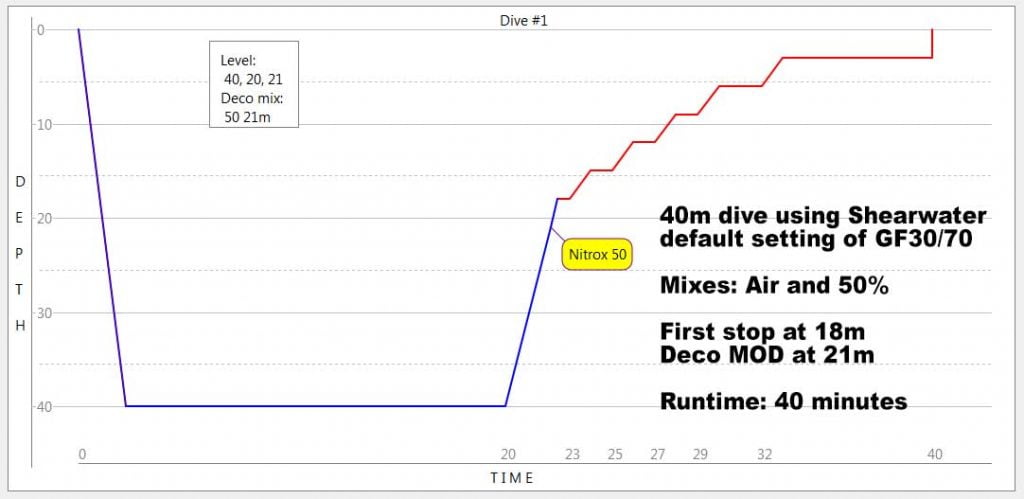
A simple downwards tweak of GFlo to a setting of 25/70 drops our first mandated stop down to 21m. This corresponds with our mix MOD and gas switch. The runtime increases by 1 minute to reflect the length of that extra stop. However, we have simplified our ascent plan and added some extra conservatism with respect to the extra 1 minute of off-gassing. For those concerned over micro-bubbles, the deeper stop on a richer mix will have some extra effect on faster-tissue bubble resolution.
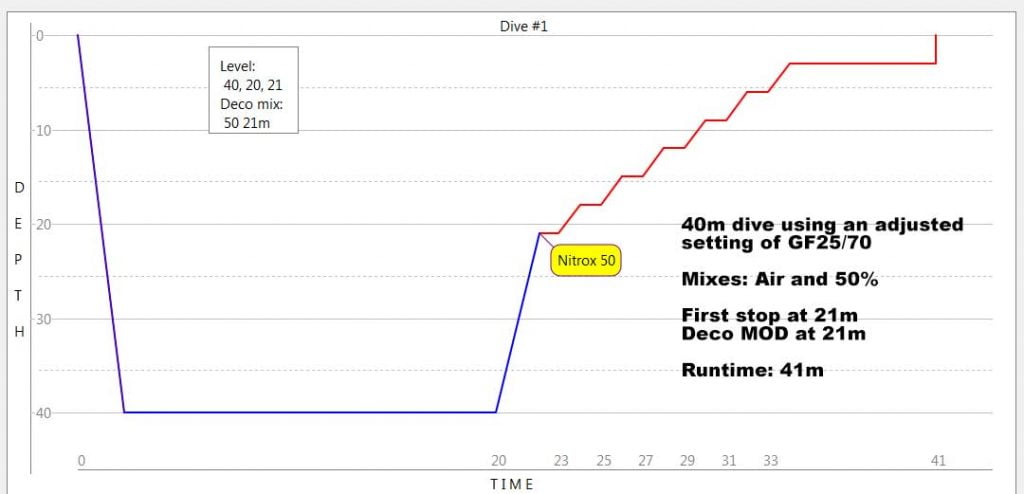
GFlo example 2:
Let’s look at the opposite case – in this instance a 50m dive, also for 20 minutes using air and 50%. Again, we start with the Shearwater default settings of GF 30/70. We can see that the model now mandates the first stop at 24m. This is below our deco mix MOD of 21m. During this stop, we can assume that our slow-tissue will further on gas.
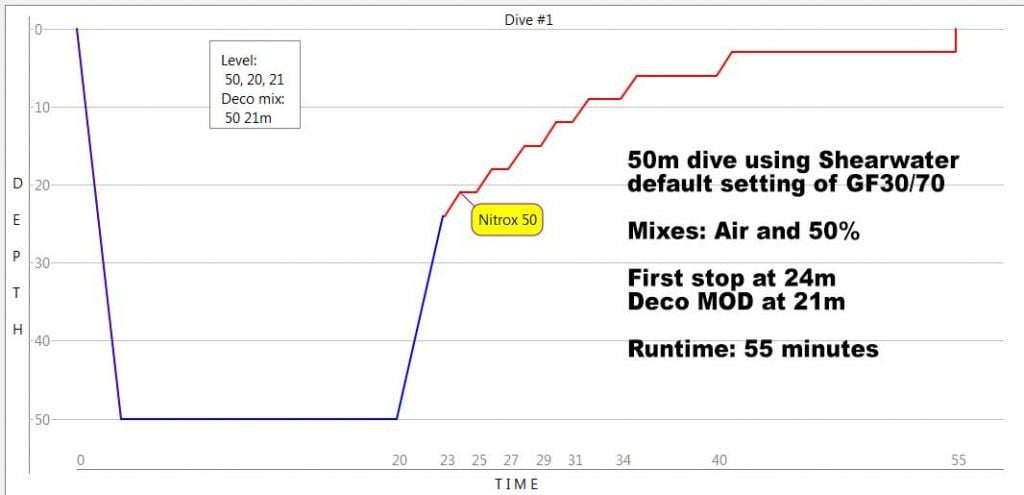
In this instance, a small upwards refinement of GFlo to a 40/70 setting neatly coincides our first designated stop with our deco mix MOD. In doing so, we have cut 2-minutes from the overall run-time; a result of eliminating stop time that served no benefit, along with avoiding the consequent slow-tissue penalty that had to be paid in the shallow deco (6m and 3m stops) phase of the dive.
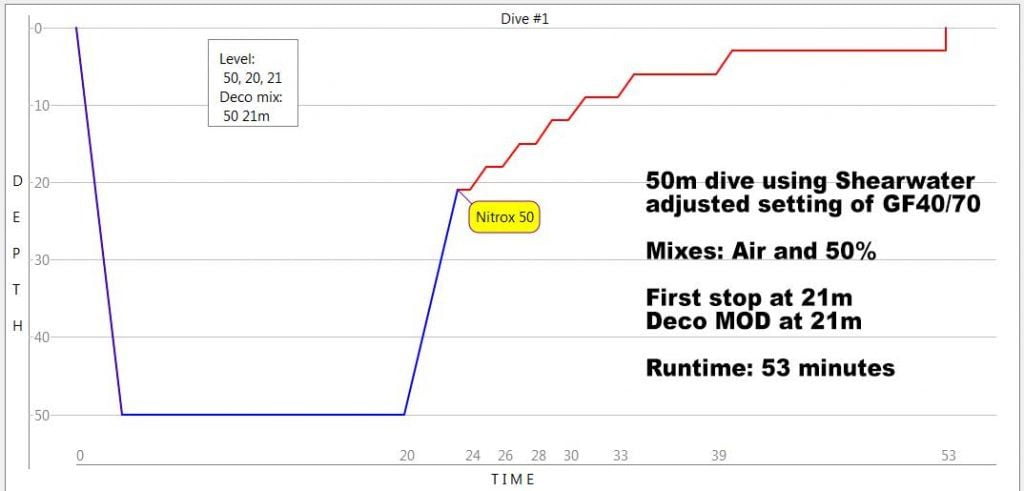
Even in these small-scale examples, the principles start to demonstrate where systematic adjustment of GFlo promotes both decompression efficiency and conservatism benefits.
Setting GF High
The Gradient Factor High (GFhi) setting determines the overall length of decompression, with a ratio bias towards shallow/O2-range decompression. The lower the number, the longer the decompression mandated.
This boils down to a rather simple means of controlling the overall conservatism of your deco dive.
If GFhi 100 (%) is zero conservatism (raw m-value), then any deduction from that number is a % conservatism value.
So, a GFhi setting of 70 equates to 30% conservatism below that absolute safety threshold. A GFhi of 85 gives just 15% conservatism. Simple.

Obviously, I won’t try to suggest how much conservatism YOU need in YOUR decompression schedules. It’s a personal factor – and should take account of both your specific physiology and long-term and day-to-day DCS predisposition factors.
A nominal setting for one diver may be hyper-aggressive for another. And vice-versa. There’s no magic formula to arrive at an ideal setting.
Experienced technical divers pay close attention to their post-dive vitality and learn to tailor their conservatism based on subtle (or not so subtle) feedback from inside their bodies. Less experienced divers have to build up their experience and gain reliable confidence in how much DCS tolerance they have.
DCS susceptibility is a bell curve
DCS susceptibility is a bell curve and you have to accrue lots of experience to learn where you float on that demographic spread. Some people won’t symptomatically bend after ridiculously fast ascents or huge amounts of missed deco. Others can bend on the most benign of shallow no-stop dives. Everyone else lies somewhere in between.
You may call me a prude, but I’d suggest that it’s best to learn your tolerances without having to visit a recompression chamber.
You’ll never be aware of the occasions when you WOULD have gotten bent but were otherwise saved by a sufficiently conservative schedule. You’ll only ever learn such a definitive lesson if you do get bent. Try to avoid that lesson – it sucks. Just ask anyone who’s learned it.
Judging your DCS tolerance takes a lot of dives
Likewise, don’t think that a few hundred dives are anywhere near sufficient to have determined your general DCS susceptibility. You have to dive enough times, inside a given range, to have given the ill-omened stars ample chance to align and try to kick your arse.
So in that respect, start with a low GFhi and slowly throttle back your conservatism over many, many repeated dives. Patience and self-discipline help with the application of that strategy. If/when you feel physically sub-optimal post-dive, it’s time to back off and drop your GFhi down a notch, or two.
Summary of my GF setting method
- For a given dive, identify the MOD of the first gas you’ll switch onto during ascent (appropriate travel gas or 50%).
- Adjust the GFlo to coincide the first stop with your first gas switch at MOD.
- If that happens to provoke a significant variation in stop depth, take some time to apply common sense and also reconsider what gasses you might use.
- Adjust the GFhi to provide an overall level of prudent conservatism for the deco.
That’s it. Super easy-peasy and you no longer need to dive using default gradient factor settings or lurk on techie internet forums listening to irrelevant debates by CCR divers…
For those wishing to read more, I have written a case-study example of three Gradient Factor profiles on a 60m trimix dive:
A Gradient Factor Comparison Using A Simple 60m Trimix Dive Case-Study
About The Author

Andy Davis is a RAID, PADI TecRec, ANDI, BSAC, and SSI-qualified independent technical diving instructor who specializes in teaching sidemount, trimix, and advanced wreck diving courses.
Currently residing in Subic Bay, Philippines; he has amassed more than 10,000 open-circuit and CCR dives over three decades of challenging diving across the globe.
Andy has published numerous diving magazine articles and designed advanced certification courses for several dive training agencies, He regularly tests and reviews new dive gear for scuba equipment manufacturers. Andy is currently writing a series of advanced diving books and creating a range of tech diving clothing and accessories.
Prior to becoming a professional technical diving educator in 2006, Andy was a commissioned officer in the Royal Air Force and has served in Iraq, Afghanistan, Belize, and Cyprus.
In 2023, Andy was named in the “Who’s Who of Sidemount” list by GUE InDepth Magazine.
Purchase my exclusive diving ebooks!
Originally posted 2019-02-13 19:34:04.









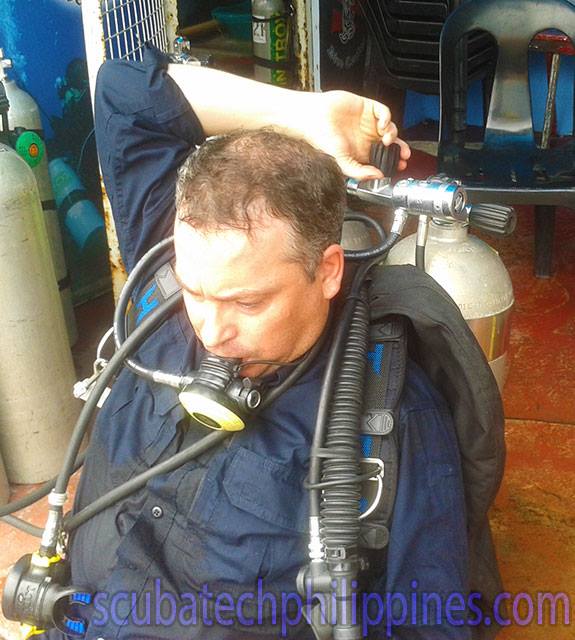
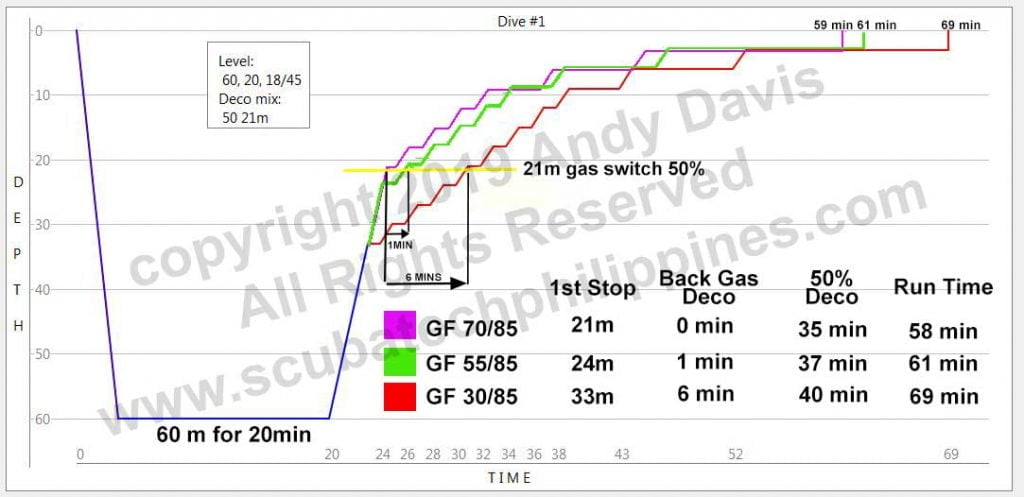
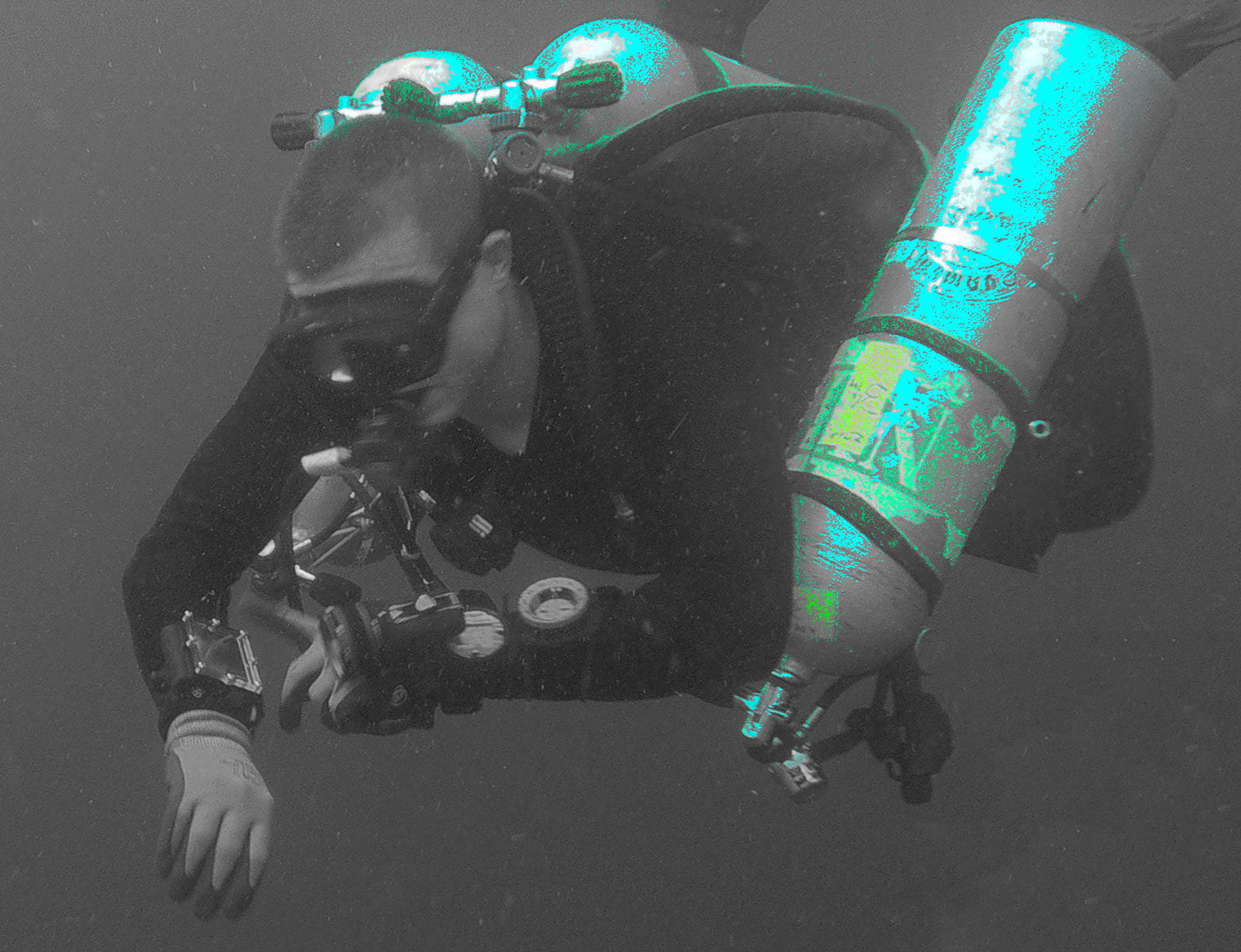
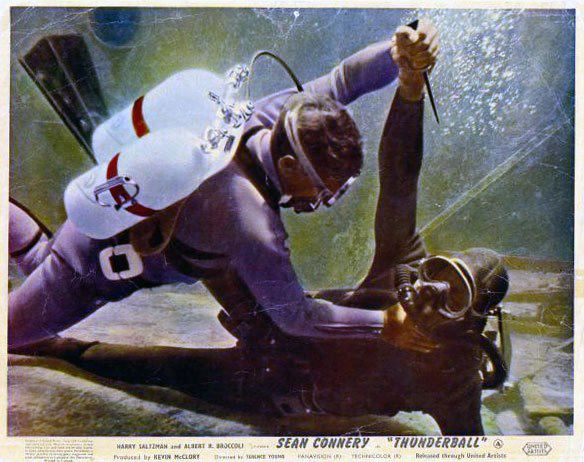
Again this old, but anyway:
* First picture You mention, that the first profile was obtained from Shearwater, but it clearly shows it is from Vplanner/Multideco (Shearwater shows runtime 35 minutes)
* How large difference would you expect between 25/70 and 30/70 on dive to 40 m? It is clearly not in the runtime, but in the tissues stress, which counts here. So here you need to provide tissue stress heatmap, e.g. from Subsurface app.
* I dont think profile to 50 m on air is a good example, even it is still valid for some agencies.
* Your prediction shown here only works around 40 m with Ean50 (switch 21 m). Consider examples like 25 m, long deco dive and deco gas only Oxygen. Or consider dive to 50-60m range on trimix, with Ean50 as first deco gas.
* Do you think, that how i feel after dive is good measure for quality of the decompression? If i am tired, it doesnt have to mean high deco stress, it only means, that may be you worked harder during the dive. The only know measure is VGE.
Of course, this advice should at best be used within limits: Fudging deco parameters (GFlow in this case) to fit your preconceptions how your ascent should work (i.e. predetermined first stop depth) can go pretty wrong. At some point, you need to adjust the MOD of your first deco gas to fit stop depth rather than the reverse. Plus you might use a program like Subsurface to figure out what the other compartments are actually doing rather than speculating about this.
The second warning is about putting too much trust into “close attention to post dive vitality” as too many factors influence these and everybody is prone to fall into the trap of self delusion. If deco quality could easily be felt we wouldn’t need any Dopplers and complicated theory. But the truth is, you need thousands of dives to obtain reasonable statistics and objective criteria. I would put very little credibility into anecdotal evidence from a diver reporting “feeling great after a dive”. As a gauge, go back into old debates of the advantages (“I felt so much warmer after paying more for the gas in the suit inflation bottle”) of filling your suit with argon rather than air (note: not trimix) where physics suggests the difference being at best minimal.
Dear Andy, great article. Regarding the deep stop I would say in your examples the 21 m first deco stop coincides approximately with a calculated deep stop at 50% of the max depth. Hence the theory of abandoning a deep stop comes into consideration from 60 m or deeper, where the use of OC becomes more and more obsolete.
Thanks for your feedback. I echo your sentiments in regards to varying GFhi in response to differing DCS predisposition factors. My own nominal setting is GFhi85, but I don’t hesitate to drop down to GFhi70 if I’m feeling at all sub-par, or I predict sub-optimal dive conditions.
Even when diving GFhi85, I’ll do contingency gas planning based on a switch to GFhi70 as the dive progresses. A good feature on true modern technical computers is that you can adjust GFhi ‘on-the-fly’ to cope with changing circumstances – you just need a gas plan that encompasses that option.
I’m currently working on some follow-on articles that will be presented as case-studies to show variance between differing gradient factors and gases for example dives. This should go further to explain fast-tissue/slow-tissue reasoning. I’m also mid-way through a case study that critically examines shallow-range tech deco gas options.
The aim, as always, is merely to provoke discussion and help understanding of varied factors and philosophies. There’s no right or wrong, except for the clang of a chamber door.. :)
Well written article with good reasoning.
May I add some thoughts after having calculated several dive profiles (Bühlmann compartments, tissue tension and CNS)?
The curves show exactly that low tissues continue to saturise on deep stops.
While micro bubble problems may cause immediate DCS hits, deep stops can solve the obvious. Problems in the lowest compartments, especially bone marrow, will only show in the long run — probably only after years. This is common knowledge for commercial/saturation divers, who are especially careful about this.
I do have a rule of thumb for GF HI: The colder the water and the more work load, the more conservatism I use (ranging from 70 to 85%).
The other remark is on oxygen rich decompression using “standard” gases (Nx50 and O2): This comes at the price of high CNS saturation. Using 80% for the last stop and s.th. lower than 50 %, like 32%, you start decompression earlier (deeper), have the same overall decompression time, but roughly only 50% of the CNS saturation compared to 50/100. When using Helium as bottom gas, there may be the need to add some to the first deco gas to stay within the 20% rule, though.
Another thought may be on safety. If you loose your buddy (I have seen this happen) and have a massive back gas problem, there will be a problem ascending to a depth low enough th breathe the first deco gas.